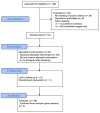Lactase-Treated A2 Milk as a Feasible Conventional Milk Alternative: Results of a Randomized Controlled Crossover Trial to Assess Tolerance, Gastrointestinal Distress, and Preference for Milks Varying in Casein Types and Lactose Content
- PMID: 40573057
- PMCID: PMC12196342
- DOI: 10.3390/nu17121946
Lactase-Treated A2 Milk as a Feasible Conventional Milk Alternative: Results of a Randomized Controlled Crossover Trial to Assess Tolerance, Gastrointestinal Distress, and Preference for Milks Varying in Casein Types and Lactose Content
Abstract
Background: Previous research indicates that gastrointestinal discomfort from milk consumption may be attributable to A1 β-casein, rather than lactose intolerance alone. A2 milk (free of A1 β-casein) consumption may result in fewer symptoms compared to conventional milk containing both A1/A2 β-casein. Objective: In this five-week, double-blind, double-crossover study, we assessed the physiological responses to doses escalating in volume of lactose-free conventional milk (Lactaid), A2 milk, and lactose-free A2 milk in fluid milk-avoiding participants. Methods: Each milk type was consumed over three separate weeks with three increasing doses across five days per week, >one week washout. Gastrointestinal symptoms, blood glucose, and breath gases were monitored for twenty-four, two-, and three-hours post-consumption, respectively. Sensory evaluation was completed for each sample. Results: Fifty-three participants consented and were randomized, with forty-eight participants completing the study. Overall, symptoms were minimal. On Days 1 and 3, lower ratings of bloating and flatulence were observed in A2 compared to lactose-free A2. Breath hydrogen responses reflected lactose content, but were higher in lactose-free A2 than Lactaid on Day 5. Thirty-three participants were deemed lactose-intolerant and had higher fasting and average breath hydrogen for all samples. The only symptom corresponding to the increase in breath hydrogen among these participants was flatulence after A2 consumption. Surprisingly, flatulence was apparently higher for lactose-tolerant individuals when consuming Lactaid compared to A2. Conclusions: These findings suggest that adults who avoid conventional fluid milk consumption may experience minimal GI discomfort from lactose-free and/or A1-free milks.
Keywords: A2 milk; beta-casein; breath hydrogen; fluid milk; gastrointestinal tolerance; lactose.
Conflict of interest statement
The authors declare no conflict of interest.
Figures







Similar articles
-
Milk Containing A2 β-Casein ONLY, as a Single Meal, Causes Fewer Symptoms of Lactose Intolerance than Milk Containing A1 and A2 β-Caseins in Subjects with Lactose Maldigestion and Intolerance: A Randomized, Double-Blind, Crossover Trial.Nutrients. 2020 Dec 17;12(12):3855. doi: 10.3390/nu12123855. Nutrients. 2020. PMID: 33348621 Free PMC article. Clinical Trial.
-
Tolerance of protein-hydrolyzed lactose-free A1 milk and A2 milk in lactose-tolerant and lactose-intolerant volunteers: A randomized crossover trial with 2 parallel groups.J Dairy Sci. 2025 Sep;108(9):9062-9077. doi: 10.3168/jds.2025-26712. Epub 2025 Jul 3. J Dairy Sci. 2025. PMID: 40614809 Clinical Trial.
-
Comparison of the impact of bovine milk β-casein variants on digestive comfort in females self-reporting dairy intolerance: a randomized controlled trial.Am J Clin Nutr. 2020 Jan 1;111(1):149-160. doi: 10.1093/ajcn/nqz279. Am J Clin Nutr. 2020. PMID: 31773165 Clinical Trial.
-
Drugs for preventing postoperative nausea and vomiting in adults after general anaesthesia: a network meta-analysis.Cochrane Database Syst Rev. 2020 Oct 19;10(10):CD012859. doi: 10.1002/14651858.CD012859.pub2. Cochrane Database Syst Rev. 2020. PMID: 33075160 Free PMC article.
-
Sertindole for schizophrenia.Cochrane Database Syst Rev. 2005 Jul 20;2005(3):CD001715. doi: 10.1002/14651858.CD001715.pub2. Cochrane Database Syst Rev. 2005. PMID: 16034864 Free PMC article.
References
-
- Swagerty D.L., Jr., Walling A.D., Klein R.M. Lactose intolerance. Am. Fam. Physician. 2002;65:1845–1851. - PubMed
-
- Sharp E., D’Cunha N.M., Ranadheera C.S., Vasiljevic T., Panagiotakos D.B., Naumovski N. Effects of lactose-free and low-lactose dairy on symptoms of gastrointestinal health: A systematic review. Int. Dairy J. 2021;114:104936. doi: 10.1016/j.idairyj.2020.104936. - DOI
Publication types
MeSH terms
Substances
Grants and funding
LinkOut - more resources
Full Text Sources

